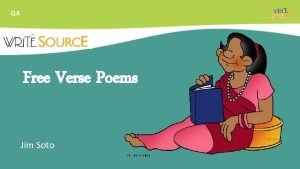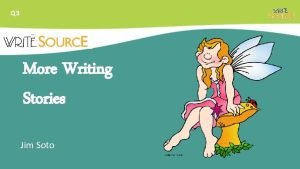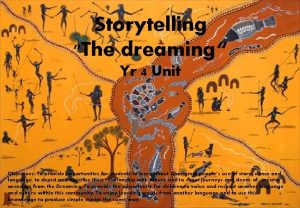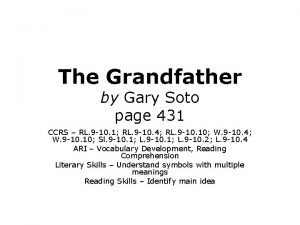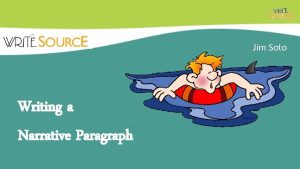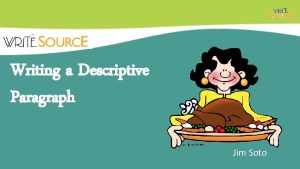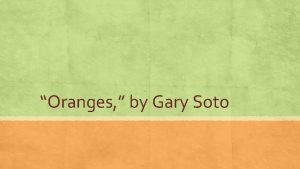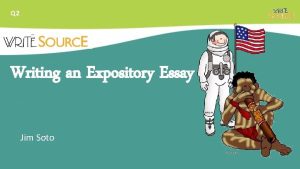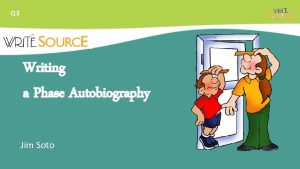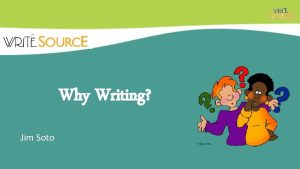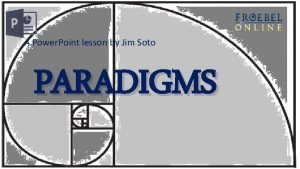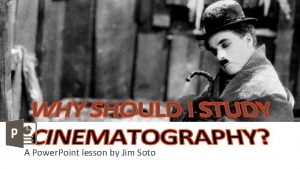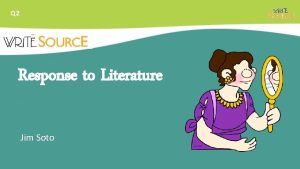Q 3 More Writing Stories Jim Soto Lesson


















- Slides: 18

Q 3 More Writing Stories Jim Soto

Lesson Objective ØUnderstand the content and structure of a short story ØChoose a topic to write about ØPlan, draft, revise, and edit a short story Pages 346 -352

Writing a Short Story Everybody loves a story! Today you will begin writing your own story. It will be about an important decision that the main character will need to make. It’s important that you make it as entertaining as possible.

Prewriting

Short Stories: Selecting a Topic A choice or decision in a story is as interesting as the character behind it. A first step in writing a story should be creating an interesting character (or characters). Pg. 346 has a diagram you can use to make this step easier.

Short Stories: Creating a Conflict Tough decisions create greater conflicts for the characters. Great conflicts make for great stories! Remember that conflict is what fuels a story. Pg. 346 has a decision list you can use to either choose or get ideas from.

Short Stories: Setting the Scene The place and time in which your story takes place should make solving the conflict more difficult. The more challenging, the more interesting the story can be. Pg. 347 has a sensory chart you can use to either choose or get ideas from.

Drafting (“group up” for a while)

Short Stories: Write a 1 st Draft Now that you have you main components, it’s time to write a draft of the story ( pg. 348). Share story ideas with your team mates for immediate feedback by: Øfolding a paper into thirds Øwriting a different beginning in each row Øpassing the paper around for feedback from your peers about which is best

Revising

Short Stories: Improve It! As you revise make sure use details and dialogue that show, not tell the reader what is happening. Add details: Øthat help the reader see, hear, smell, taste, and feel what’s happening. Øabout a character’s movements, facial expressions or gestures. Øthat create more distinctive dialogues.

Editing

Short Stories: Check for Conventions Double. . . Triple. . . Quadruple check for conventions. And after you’ve done that, maybe now is a good time to create a title for your story! Check for tips in page 349.

Publishing

Short Stories: Share the Story! To publish it, type the story in your computer. Try drawing a cover for it that depicts an important scene from the story. Place it over your final version and share it!

Story. Patterns and Elements Read Story Patterns & Elements of Fiction, in pages 350 -352 of your book, then complete the Try It assessment at the end. Prepare for a discussion in fifteen minutes.

Homework YIPE! In your Skills Book complete pgs. 112114. Ø Sentence Problems Review 3 Ø Combining Sentences Using Key Words

Next Research Writing Jim Soto © 2016
 More more more i want more more more more we praise you
More more more i want more more more more we praise you More more more i want more more more more we praise you
More more more i want more more more more we praise you Bad weather poem
Bad weather poem Jim soto
Jim soto Twenty rules for writing detective stories
Twenty rules for writing detective stories How to write a dreamtime story
How to write a dreamtime story The more you take the more you leave behind
The more you take the more you leave behind The more you study the more you learn
The more you study the more you learn Aspire not to
Aspire not to Newtons first law example
Newtons first law example Knowing more remembering more
Knowing more remembering more The more i give to thee the more i have
The more i give to thee the more i have More choices more chances
More choices more chances Human history becomes more and more a race
Human history becomes more and more a race Gary soto interview
Gary soto interview The grandfather by gary soto
The grandfather by gary soto The drive in movies gary soto
The drive in movies gary soto The challenge by gary soto
The challenge by gary soto Hector soto rodriguez
Hector soto rodriguez


